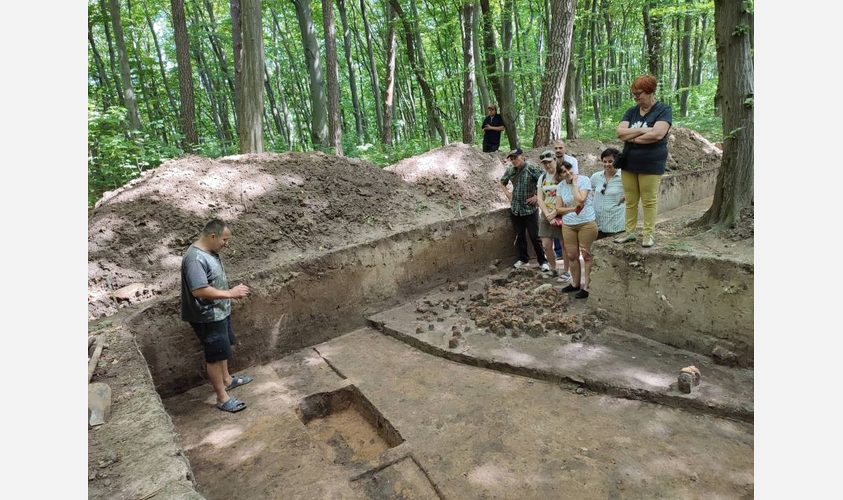In Vynnyky, archaeologists continue to study the settlement of the ware ware culture. Eneolithic expedition of the Institute of Ukrainian Studies named after I. Krypyakevych of the National Academy of Sciences of Ukraine, as part of scientific staff of the Department of Archeology Andrii Gavinskyi and Yana Yakovyshina, conducts relevant research on Mount Lysivka.
The settlement on this mountain is one of the few fortified points on the territory of the southeastern group of this culture and the first discovered in Western Ukraine. This year’s discoveries make it possible to date the settlement of the ware ware culture in Vynnyky around 3500 BC.
According to the archeology department of the Institute of Ukrainian Studies named after I. Krypyakevych of the National Academy of Sciences of Ukraine, the ware ware culture is one of the largest European early agricultural communities of the 4th millennium BC. e., which covers the territory from the south of Scandinavia to the west of Ukraine. Its southeastern border runs along the headwaters of the Dniester and Western Bug within the limits of the modern Lviv and Volyn regions of Ukraine. The Trypil culture stood in the way of its further advancement to the east. Most of the known ware culture settlements in this region are located on the heights, which are often called mountains.
The settlement in Vynnyky occupies an elongated, triangular ridge of the Lysivka mountain, 321 m above sea level, and is a dominant point over the wide valley of the Marunka River. From a defensive point of view, the mountain has advantageous natural advantages with steep slopes on three sides and a flat, habitable square. Such a place to live was not chosen by chance. Representatives of the ware ware culture stayed here for a long time, built strong clay houses, economic facilities, engaged in agriculture, production, bred domestic animals, etc. Sensing some unrest in this border area, the residents of Lysivka decided to provide themselves with additional artificial fortifications. Thus, a moat was dug from the accessible western side of the settlement, the visual contours of which can be traced even today.
This year’s archaeological research established that above this arc-shaped ditch, parallel to it, there was also a line of palisade. She additionally protected the settlement. The object has certain design features. First, the builders of this wall dug a trench 30 cm wide and up to 50 cm deep with straight walls and a flat bottom. In it, logs were inserted nearby, and often hammered, the traces of which are clearly visible on the longitudinal section of the ditch.
An accumulation of clay plaster mixed with a large amount of fine charcoal was recorded nearby. On its surface, there are no visible traces of small rods, as, for example, from the remains of the walls of residential buildings. The area around the palisade is not built up, no other stationary structures were found in the excavation. These facts give reason to assume that the discovered accumulation of plastering is the remains of clay, which was plastered over the palisade to strengthen it and eliminate cracks in it.
According to the researcher of the Department of Archeology of the Institute of Ukrainian Studies named after I. Krypyakevych of the National Academy of Sciences of Ukraine, Candidate of Science Andrii Gavinskyi, obtained laboratory dates, stratigraphic observations and analysis of moving material allow us to date the settlement of the ware ware culture in Vynnyky on Mount Lysivka around 3500 BC.
The discovery gives rise to important questions and discussions about the state of intra-societal and intercultural relations on the border with Trypilly. Fortified settlements are not something new in the Eneolithic cultures of Central-Eastern Europe – such a tradition is known over a large area and at different times. However, it is extremely rare to capture them. The settlement on Mount Lysivka in Vynnyky is one of the few such points in the wide areas of the southeastern group of this culture and the first discovered in Western Ukraine.
Future research will focus on the search for the second palisade line recorded on the geomagnetic scanning plan, as well as on the excavation of the settlement entrance, which is located in the highest area between the moat gaps.
The research is carried out in cooperation with the Institute of Archeology of the University of Rzeszów (Poland), the Historical and Local History Museum of Vinnyki and the Ivan Franko National University of Lviv.
We will remind you that last year LKP “Heritage Bureau” together with the department of archeology of the Institute of Ukrainian Studies named after I. Krypyakevich, the National Academy of Sciences of Ukraine organized an exhibition in Lviv dedicated to the archaeological finds of the largest European archaeological cultures of the Eneolithic IV – early III millennium BC. e., found in Vynnyky, in Lviv on Zamkova Gora and Levandivka.

